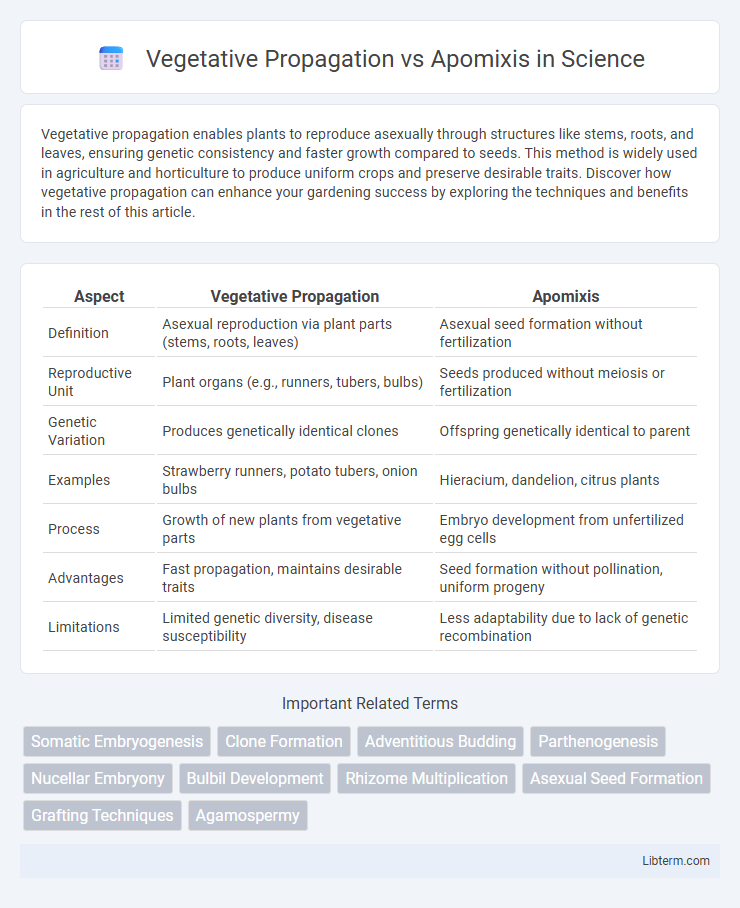Vegetative propagation enables plants to reproduce asexually through structures like stems, roots, and leaves, ensuring genetic consistency and faster growth compared to seeds. This method is widely used in agriculture and horticulture to produce uniform crops and preserve desirable traits. Discover how vegetative propagation can enhance your gardening success by exploring the techniques and benefits in the rest of this article.
Table of Comparison
| Aspect | Vegetative Propagation | Apomixis |
|---|---|---|
| Definition | Asexual reproduction via plant parts (stems, roots, leaves) | Asexual seed formation without fertilization |
| Reproductive Unit | Plant organs (e.g., runners, tubers, bulbs) | Seeds produced without meiosis or fertilization |
| Genetic Variation | Produces genetically identical clones | Offspring genetically identical to parent |
| Examples | Strawberry runners, potato tubers, onion bulbs | Hieracium, dandelion, citrus plants |
| Process | Growth of new plants from vegetative parts | Embryo development from unfertilized egg cells |
| Advantages | Fast propagation, maintains desirable traits | Seed formation without pollination, uniform progeny |
| Limitations | Limited genetic diversity, disease susceptibility | Less adaptability due to lack of genetic recombination |
Introduction to Plant Reproduction Strategies
Vegetative propagation involves the growth of new plants from non-reproductive parts such as stems, roots, or leaves, enabling rapid cloning of the parent plant. Apomixis is a form of asexual reproduction where seeds develop without fertilization, producing offspring genetically identical to the mother plant. Both strategies bypass sexual reproduction, offering advantages in stability and uniformity for agricultural and horticultural practices.
Definition of Vegetative Propagation
Vegetative propagation is an asexual reproduction method in plants where new individuals are produced from the vegetative parts such as stems, roots, or leaves, without the involvement of seeds or spores. This process results in offspring genetically identical to the parent plant, ensuring uniformity and rapid multiplication. Unlike apomixis, which involves seed formation without fertilization, vegetative propagation relies solely on vegetative organs for propagation.
Definition of Apomixis
Apomixis is a form of asexual reproduction in plants where seeds develop without fertilization, producing offspring genetically identical to the parent plant. Unlike vegetative propagation, which relies on the growth of new plants from stems, roots, or leaves, apomixis bypasses the fusion of gametes entirely. This process ensures rapid and stable propagation of desirable traits through seed formation without genetic variation.
Key Differences Between Vegetative Propagation and Apomixis
Vegetative propagation involves the growth of new plants from specialized structures like stems, roots, or leaves of the parent plant, resulting in genetically identical clones, whereas apomixis produces seeds without fertilization through embryogenesis from maternal tissues. In vegetative propagation, the offspring arise from asexual parts of the plant, while apomixis bypasses sexual reproduction by forming seeds that maintain genetic uniformity. Key differences include the mode of reproduction, the plant structures involved, and the form of offspring produced--vegetative organs versus seeds.
Mechanisms of Vegetative Propagation
Vegetative propagation involves the growth of new plants from specialized structures such as stems, roots, or leaves, enabling genetic clones of the parent plant to develop without seed formation. Key mechanisms include the formation of adventitious roots from stem cuttings, the development of runners in strawberry plants, and tuber formation in potatoes, which facilitate efficient asexual reproduction and rapid plant spread. This process contrasts with apomixis, where seeds are produced asexually through embryo development without fertilization, maintaining genetic uniformity across generations.
Types of Apomixis in Plants
Apomixis in plants primarily occurs through two main types: gametophytic and sporophytic apomixis. Gametophytic apomixis involves the formation of an embryo from an unreduced egg cell within the embryo sac, bypassing fertilization, while sporophytic apomixis, also called adventitious embryony, produces embryos directly from somatic tissues of the ovule. Vegetative propagation differs as it reproduces plants asexually through vegetative parts like stems, roots, or leaves, without seed formation, unlike apomixis which involves seed development without fertilization.
Advantages of Vegetative Propagation
Vegetative propagation offers rapid plant multiplication with genetic uniformity, ensuring true-to-type offspring that maintain desirable traits. It allows the production of mature plants in a shorter time compared to seed-based methods, enhancing agricultural efficiency. This method also enables propagation of plants that do not produce viable seeds or have low germination rates, expanding the range of cultivable species.
Benefits of Apomixis
Apomixis offers the significant benefit of producing genetically uniform offspring without the need for fertilization, ensuring consistent crop traits and superior yield stability. This asexual reproductive mechanism accelerates plant breeding by bypassing genetic recombination, preserving desirable traits across generations. In contrast to vegetative propagation, apomixis enables seed production with the advantages of ease of storage and distribution while maintaining hybrid vigor.
Applications in Agriculture and Horticulture
Vegetative propagation enables rapid multiplication of genetically identical plants, making it ideal for maintaining desirable traits in crops like potatoes and strawberries. Apomixis produces seeds without fertilization, offering uniform offspring and preserving hybrid vigor in crops such as citrus and grasses. Both methods enhance agricultural productivity by ensuring consistency and accelerating plant breeding programs in horticulture.
Challenges and Future Prospects
Vegetative propagation faces challenges such as limited genetic diversity and vulnerability to diseases, which can reduce crop resilience and yield stability. Apomixis offers the potential to produce genetically uniform offspring without fertilization, overcoming hybrid seed production constraints and preserving desirable traits across generations. Future research aims to harness apomixis for sustainable agriculture by integrating it into major crops, improving food security through cost-effective, clonal seed production.
Vegetative Propagation Infographic

 libterm.com
libterm.com